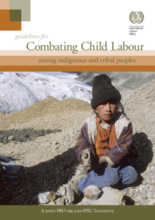Recent consultations undertaken by the ILO in Kenya, the Philippines and Guatemala have confirmed that there is little awareness about child labour issues among indigenous peoples; that previous child labour studies and research largely ignore indigenous communities; and that few programmes and projects address indigenous child labour.
It has, however, also become increasingly clear that indigenous children are disproportionately affected by the worst forms of child labour. Specific approaches are needed to effectively combat child labour among indigenous peoples.
The following guidelines have been elaborated in order to provide practical guidance to ILO staff and partners on how to address the specific needs and rights of indigenous peoples - and thus combat child labour among indigenous children.
The elaboration of the guidelines was undertaken in collaboration between two specialised programmes of the ILO: The International Programme to Eliminate Child Labour (IPEC) and The Programme to Promote ILO Policy on Indigenous and Tribal Peoples (PRO 169). The guidelines should be seen as a supplement to the very comprehensive guidelines elaborated by IPEC/Time Bound Programme (TBP), which constitute an important frame of reference and in many cases can be used in the work towards the elimination of indigenous child labour. However, the TBP guidelines address child labour in general and do not take into account the specificities of indigenous peoples and their children. These call for specific considerations, approaches and solutions.
The guidelines are structures in four main parts:
PART I: A rights-based approach to indigenous child labour: This section introduces the major arguments for addressing indigenous child labour specifically, emphasizing the relevance and principles of a rights-based approach, within the framework of ILO Conventions Nos. 138, 169 and 182.
PART II: Education to combat child labour: This section identifies the existing barriers to education and looks at the specific rights and needs of indigenous children with respect to school education and vocational training.
Part III: Operational challenges, principles and opportunities: This section outlines a number of operational opportunities for ensuring indigenous participation in the programming cycle of child labour initiatives.
Part IV: For more information: This section provides references to additional information resources on key topics.
©International Labor Organization

